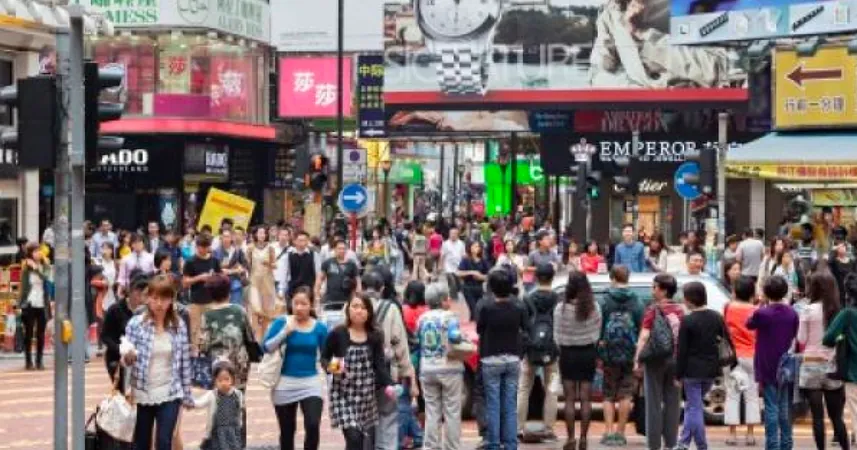
The Current State of Hong Kong's Retail Sector: Challenges and Bright Spots
2025-09-22
Author: Ting
Hong Kong's retail scene is navigating stormy waters, but there’s a glimmer of hope amid the turbulence. In its latest report, Savills highlights that the second quarter of 2025 has been tough for retail, with significant factors impacting sales performance.
Despite a year-on-year increase of 16% in same-day tourist arrivals, retail sales in Hong Kong have shown only marginal improvement—with May recording a 2.4% uptick and June barely scraping a 0.7% rise. The overall retail sales increase for the quarter sits at just 0.3%, a stark contrast to the 13-month consecutive decline in the preceding months.
Savills points out that Hong Kong residents are increasingly opting to spend their money across the border in Mainland China. A study from CUHK, based on AlipayHK data from 4.5 million users, revealed that over two-thirds of regular spenders from Hong Kong are diverting their shopping habits northward. Notably, nearly half of their spending is going towards services and about 28% on retail, which signifies a troubling trend for local businesses.
This shift reflects a permanent change in consumption habits, expanding beyond major cities like Shenzhen and Guangzhou to smaller hubs like Zhongshan and even far-off Chongqing. AlipayHK reported that over 2 million Hong Kong users adopted its platform for Mainlander shopping in just a year, with a noticeable shift from luxury goods to everyday essentials.
The negative fallout from these trends has led to a wave of closures in various sectors. More than 300 retail outlets shut their doors in the first half of 2025, with 70% of those in the food and beverage sector losing significant ground. The cinema industry has also taken a hit, reporting a 16% year-on-year revenue drop, marking its weakest performance since 2011.
However, not all news is bleak. The second quarter of 2025 has seen some encouraging trends emerge, with budget and value-focused retail concepts gaining traction. International brands, like the Japanese store 3 Coins, have made a splash in the market, breaking sales records in their first day and attracting long lines with prices starting as low as HK$18.
Local initiatives are also thriving; T.momo Shopping Mall has rolled out 13 new stores targeting residential neighborhoods, with plans for 17 more in the fiscal year 2025, focusing on affordable furniture.
In the food and beverage landscape, innovative concepts are popping up. Takeaway options offering family-friendly meals are on the rise, exemplified by dishes available in the HK$35-43 range, reflecting a creative response to current consumer needs.
Furthermore, the financial services sector is expanding its physical presence in key retail areas like Causeway Bay, with platforms like Futu Securities positioning flagship branches to boost customer engagement.
Cultural and entertainment events are also stirring up retail momentum. A surge of 18% in overseas visitors during major events like ComplexCon and Art Basel equates to increased spending and heightened foot traffic.
Large-scale infrastructure projects such as the "Skytopia" development, the Hung Hom Promenade revitalization, and the forthcoming Victoria Cove waterfront district promise to reshape Hong Kong’s urban landscape. By integrating lifestyle experiences with entertainment and culture, these projects lay the groundwork for future retail growth, reinforcing the city’s standing as a premier global lifestyle destination.




 Brasil (PT)
Brasil (PT)
 Canada (EN)
Canada (EN)
 Chile (ES)
Chile (ES)
 Česko (CS)
Česko (CS)
 대한민국 (KO)
대한민국 (KO)
 España (ES)
España (ES)
 France (FR)
France (FR)
 Hong Kong (EN)
Hong Kong (EN)
 Italia (IT)
Italia (IT)
 日本 (JA)
日本 (JA)
 Magyarország (HU)
Magyarország (HU)
 Norge (NO)
Norge (NO)
 Polska (PL)
Polska (PL)
 Schweiz (DE)
Schweiz (DE)
 Singapore (EN)
Singapore (EN)
 Sverige (SV)
Sverige (SV)
 Suomi (FI)
Suomi (FI)
 Türkiye (TR)
Türkiye (TR)
 الإمارات العربية المتحدة (AR)
الإمارات العربية المتحدة (AR)